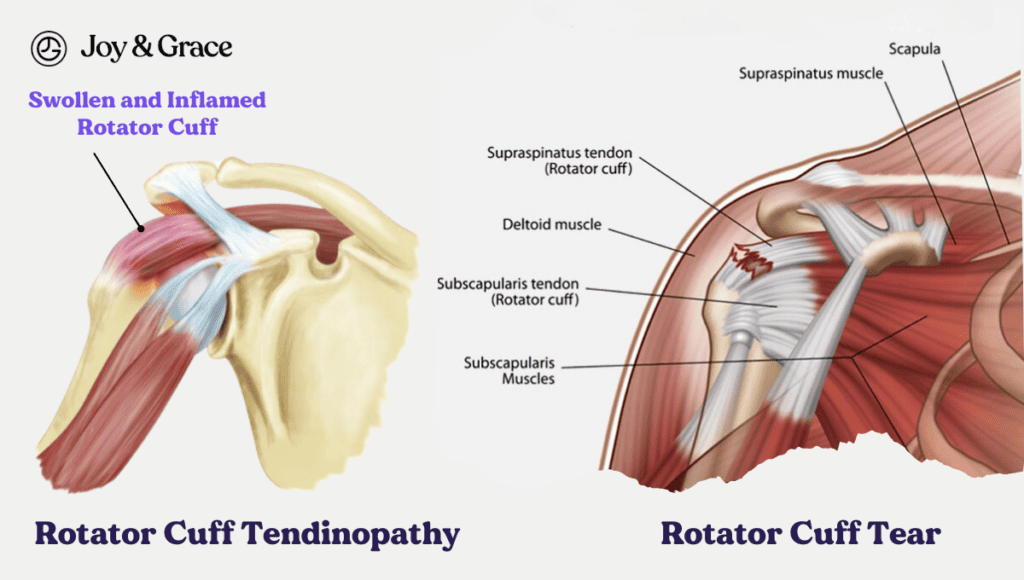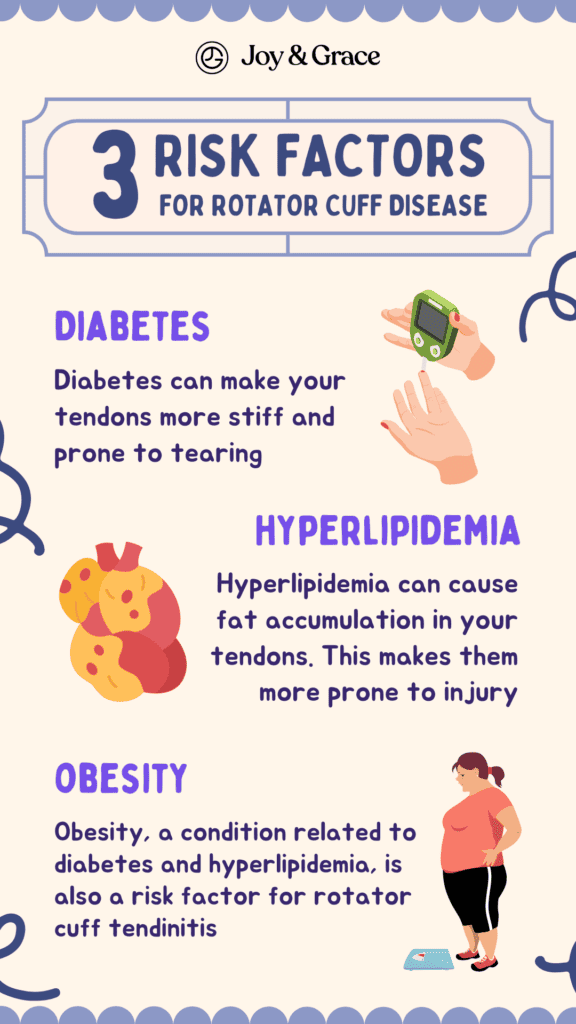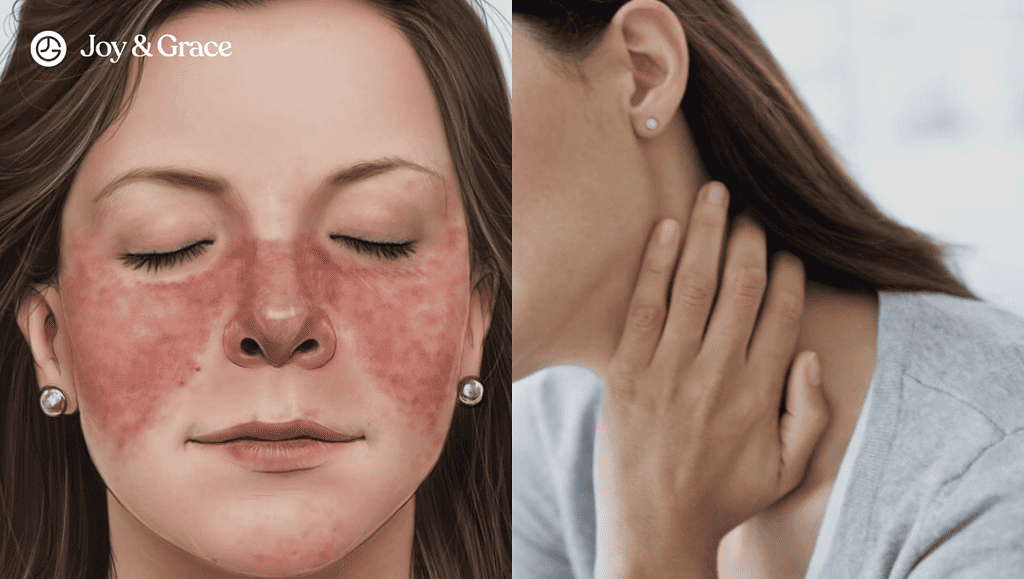You're not the only one who has experienced a sudden, sharp pain when rolling onto your left shoulder or winced as you reached for the coffee pot.
Many people experience rotator cuff shoulder pain, and it's never a welcome one. Whether it's bringing your tennis games to a premature end or making it tricky to buckle your little one into their car seat, we're here to explore the issue in depth. We're with you, shoulder to shoulder.
What Causes Pain In The Left Rotator Cuff?
Pain in your left rotator cuff is most likely due to an injury to the group of tendons and muscles that surround your shoulder joint.
This group of muscles and tendons is called the rotator cuff. It helps keep your shoulder stable and allows it to move and rotate. There are two main types of rotator cuff injuries - inflammation of the tendons (tendinitis or tendonitis) and tears.
- Rotator cuff tendonitis
This involves inflammation of the tendons of the rotator cuff. One of the most common causes is repetitive motions in the shoulder, such as frequent swinging or lifting of the arms. These movements are commonly used in sports like swimming or tennis.
The inflammation can also affect the fluid-filled sac between the rotator cuff and a part of the shoulder blade called the acromion. This is called subacromial bursitis.
This inflammation and swelling from tendinitis and bursitis can pinch the tendons and nerves of your shoulder, too. When that happens, it’s called subacromial impingement.
- Rotator cuff tears
A more severe concern is a rotator cuff tear, often resulting from a wear-and-tear effect over time or from an acute injury. It can also be the result of untreated tendinitis.

Keep in mind that pain in your right rotator cuff has similar causes. Despite whether the discomfort is in your left shoulder, right shoulder, or even both, the underlying issues often remain the same.
Can Rotator Cuff Tendinitis Affect Only The Left Shoulder?
Rotator cuff tendinitis can indeed only affect the left shoulder, causing left-side rotator cuff pain. When a rotator cuff injury affects only one shoulder, doctors call it a unilateral rotator cuff injury.
While rotator cuff tendinitis can distinctly impact just the left shoulder, it's important to note that this condition can occur on either side. This may depend on your dominant hand.
For instance, if you're a left-handed athlete, you might be more prone to developing pain in your left shoulder rotator cuff.
As an example, in one study, only 28.4% of patients reported injury to the left shoulder, while 58.1% reported injury to the right shoulder. In this study, 89% of patients were right-handed.
However, in another study, left and right rotator cuff injuries occurred at nearly equal rates—47.1% on the left side and 49.9% on the right.
Is It Possible To Injure Both Rotator Cuffs Simultaneously?
Yes, it is possible to injure both rotator cuffs at the same time. This is termed a bilateral rotator cuff injury. Luckily for you, bilateral rotator cuff injuries are quite uncommon.
In the first study mentioned, only 13.3% had bilateral injuries. In the second study, only six patients out of 178 had bilateral injuries.
Age plays a role too, though.
As we age, our likelihood of experiencing accidents increases. This also increases the risk of injuries, including those to the rotator cuff.
This is also reflected in the incidence of bilateral rotator cuff injuries. In one study, 30.6% of participants had bilateral rotator cuff injuries. The participants were aged 60–89 years old.
According to the study, the prevalence increased with the increase in age:
- Among people aged 60 to 69, 24.6% had problems on both shoulders.
- Among people aged 70 to 79, 32.3% had issues on both shoulders.
- Among people aged 80 to 89, 40.6% had problems on both shoulders.
As expected, this trend was also seen in unilateral rotator cuff injuries.
Can Left Shoulder Rotator Cuff Pain Result From Compensating For A Right-Sided Injury?
Yes, left shoulder rotator cuff pain can result from compensating for a right-sided injury or issue.
According to a study, people with a rotator cuff tear on one shoulder are at risk of developing a rotator cuff tear on the other side (contralateral shoulder).
The same study also observed that the shoulder opposite the one with the rotator cuff tendon tear often had reduced functionality.
In another study, 90% of patients who had a full-thickness rotator cuff tear also developed a complete tear on the other side.
So what does this all mean? If you have a history of a rotator cuff tear on the right shoulder, you’re more likely to develop a rotator cuff tear on your left shoulder.
In the context of a right-sided injury, here's how it can contribute to left shoulder rotator cuff pain:
- Altered posture
You may shift your body weight and posture to the left to avoid putting pressure on the right side. This can place additional stress on the left shoulder and its rotator cuff muscles, leading to overuse injuries.
- Using Your Other Arm More Frequently
When compensating for an injured right side, you may modify your everyday activities or use your left arm more frequently. These changes in movement patterns can strain the rotator cuff over time.
- Increased load on the left side
Activities that require both arms may put more load on the left side as you rely on them more. This can lead to wear and tear on the left shoulder joint and rotator cuff.
What Causes Rotator Cuff Tendinitis?
Here are some common causes and contributing factors:
- Repetitive Overuse
As mentioned earlier, repetitive movements are often the main culprit. These movements can strain the rotator cuff tendons over time. Again, this is especially true for activities that require overhead movements, such as swimming or tennis.
However, rotator cuff issues can also arise in jobs or sports that involve continuous shoulder use, even if they don't primarily involve overhead actions. Examples of such activities include carpentry and boxing.
- Muscle fatigue
Muscle fatigue can also contribute to rotator cuff tendonitis, especially in athletes.
When muscles around the shoulder, including the rotator cuff, get tired, they may not provide adequate support to the joint. This lack of support can lead to altered mechanics and increased strain on the rotator cuff tendons.
- Aging
Interestingly, your body's natural aging process also plays a role here. As you age, the tendons in the rotator cuff can naturally degenerate and become less flexible. This can make your rotator cuff more susceptible to injury.
Additionally, as highlighted earlier, the risk of such injuries rises with age, partly because of the greater likelihood of accidents or overuse affecting the shoulder area.
- Trauma or Acute Injury
An acute injury or trauma, such as a fall or direct blow to your left shoulder, can damage the rotator cuff tendons and cause tendinitis or tears.
- Poor Posture
Incorrect posture can contribute to shoulder problems. This is common if you sit at a desk or use a computer for extended periods of time. Slumping forward or hunching the shoulders can stress the rotator cuff tendons.
- Diabetes, hyperlipidemia, and obesity
Diabetes and high fat levels in the blood can also increase your risk of rotator cuff injuries. According to a study, diabetes can make your tendons more stiff and prone to tearing. Diabetes can also increase inflammation in your body, making you more prone to tendinitis.
Meanwhile, according to the same study, hyperlipidemia can cause fat accumulation in your tendons. This makes them more prone to injury. According to the study, statins, medications used to lower cholesterol, can reduce this risk.
Obesity, a condition related to diabetes and hyperlipidemia, is also a risk factor for rotator cuff tendinitis.

- Muscle Imbalances
Weak or imbalanced shoulder muscles can alter the mechanics of the shoulder joint. This imbalance can lead to abnormal stress on the rotator cuff tendons and increase the risk of tendinitis.
This is closely related to what we discussed earlier: if you have an injury on one side, like the right shoulder, you might overuse or put more strain on the other side, leading to issues like muscle imbalances in the left shoulder.
- Other Medical Conditions
Certain medical conditions, such as arthritis, can make you more susceptible to developing rotator cuff tendinitis.
What Are The Symptoms Of Rotator Cuff Tendinitis?
Regardless of which side it affects, rotator cuff tendinitis and tears often cause the following symptoms:
- Severe aching or sharp pain in the shoulder, even at rest, and often exacerbated by overhead movements.
- Weakness in the shoulder and arm. Overhead athletes (such as swimmers) may also notice a decline in performance. Performance problems usually show up as slower speed, reduced accuracy, or less endurance.
- Stiffness and reduced range of motion in the shoulder
- Tenderness when pressing on the rotator cuff muscles
- Difficulty sleeping on the affected side
- Crepitus or crunching sound when moving the shoulder
- Swelling around the shoulder joint
What Movements Aggravate Left-Side Rotator Cuff Pain?
Certain movements can significantly aggravate left or right-side rotator cuff shoulder pain. These can include:
- Overhead activity
Shoulder pain when doing overhead activities is the most common sign of rotator cuff tendinopathy. Common daily activities that hurt might include putting on a shirt, brushing your hair, or trying to reach a high cupboard.
Reaching behind the back, like putting on a seatbelt, can also be painful.
- Lifting heavy objects
Lifting heavy objects, especially with the left arm, can strain the rotator cuff muscles and cause discomfort. Incorrect lifting techniques using only your shoulder instead of your whole body can also increase discomfort.

Awkward sleeping positions where you lie on your left shoulder can also cause left-side rotator cuff pain. Nightly pressure on the shoulder can ultimately worsen your symptoms.
Can A Rotator Cuff Injury Affect Neck?
Yes, a rotator cuff injury can create havoc not only in your shoulder but also in your neck. The pain can spread to your neck because your body compensates for an injury using other muscles. In this case, your neck muscles.
Further supporting this, a study has found that the likelihood of experiencing neck problems in conjunction with rotator cuff injuries increases as people age.
However, doctors usually also check the neck distinctively, so they don't overlook any problems actually originating from the neck when treating a rotator cuff injury.
Where Does Rotator Cuff Pain Spread?
Aside from the neck, rotator cuff pain can spread to the following areas:
- Upper Arm
- Upper Back
The pain from rotator cuff problems often stops right before reaching your elbows. If it travels down the rest of your arm and to your hands, you might be dealing with a pinched nerve in your neck.
Is The Shoulder Blade Connected To The Rotator Cuff?
Yes, the shoulder blade (scapula) is connected to the rotator cuff. So, it’s no surprise that rotator cuff and shoulder blade pain can go hand in hand.
The shoulder blade plays a significant role in the functioning of the rotator cuff muscles. It provides a stable base for the rotator cuff muscles to exert force and control the movements of the shoulder joint.
Additionally, the tendons of some of the rotator cuff muscles attach to specific points on the scapula. For example, the supraspinatus tendon runs underneath the acromion process, a bony prominence of the scapula.
How Is Rotator Cuff Tendinitis Diagnosed?
Doctors typically diagnose rotator cuff tendinitis through a combination of:
- Medical history
- Physical exam
- Diagnostic tests
The process is the same whether you have rotator cuff pain in your left or right shoulder.
The doctor will start asking you about your symptoms. This can include:
- “When did the pain start?”
- “What movements worsen the pain?”
- “Does the pain spread to other areas?”
- “How has the pain affected your daily life?”
After a complete medical history, they will check your shoulder for any visible abnormalities. They will also ask you to move your arm in certain ways.
Your doctor may also use imaging tests, such as an MRI (Magnetic Resonance Imaging), to help visualize your rotator cuff and shoulder joint. Read our article on rotator cuff injuries here for a more detailed picture of the diagnosis of rotator cuff tendinitis.
How Can I Prevent Rotator Cuff Injury?

Here are some simple tips to prevent rotator cuff injuries:
- Warm Up
Always warm up your shoulder muscles before exercising or playing sports.
- Strengthen Your Muscles
Do exercises to strengthen your shoulder and upper back muscles.
- Good Posture
Maintain good posture to reduce strain on your shoulders.
- Proper Technique
Learn and use the proper techniques for sports and exercises.
- Rest and Recovery
Give your shoulders time to rest and recover after activities.
- Avoid Overuse
Don't overdo repetitive shoulder movements, especially overhead ones.
- Listen to Your Body
If you feel pain, stop what you're doing and rest.
- Stay Flexible
Include stretches in your routine to maintain shoulder flexibility.
- Lift Smart
Use your legs, not just your arms and shoulders, when lifting heavy objects.
- Consult a Pro
If you're unsure about your techniques, consider consulting a fitness trainer or physiotherapist.
With careful attention, you can reduce the chances of enduring a rotator cuff injury.
What Exercises Can Help Strengthen The Rotator Cuff?
If you have shoulder pain, it’s important to talk with your healthcare provider before engaging in any exercise.
Building strength in your rotator cuff can help manage pain and prevent future discomfort. Here are a few exercises that focus on the rotator cuff:
- Doorway Stretch
This is a simple stretch you can do anywhere. Stand in an open doorway, hold onto the sides, and lean forward to stretch your shoulder.
- Lateral Raises
Start with a light weight and slowly lift your arm sideways, repeating on each side.
- Shoulder Rolls
Rolling your shoulders can help alleviate pain in the back of the shoulder from the rotator cuff.
We have a list of more exercises here.
If you experience extreme shoulder pain, it may be wise to lessen the intensity or stop the exercise. Always listen to your body while strengthening your muscles.
Doing these exercises regularly can help improve your shoulder strength and reduce pain in the rotator cuff. However, remember that everyone's body is different, and it can be beneficial to tailor exercises to your needs.
What Is The Prognosis For Left-Side Rotator Cuff Pain?

If you’re worried that left rotator cuff pain has a worse course than the right, you can breathe easy now. According to a study, the progression of rotator cuff tears is not biased toward one side of the body over the other. This means the tear is not more likely to get worse on the body's left side than on the right.
In general, the prognosis depends on your individual condition and treatment approach. Some people may experience a complete recovery, while others may continue to have some degree of pain.
Early detection is key. Rotator cuff pain must be taken seriously, regardless of the side. When tendinitis is detected and treated early, recovery is generally quicker and more complete. Ignoring signs, such as shoulder pain when rotating the arm, could lead to further injury.
Treatment methods also play a critical role in the prognosis. Conservative treatments like physical therapy can help with symptoms and prevent damage in most cases. Additional treatments, like corticosteroid injections or surgery, may be needed if you're dealing with a more severe injury.
Recovery may take some time, so don't get discouraged if it's slow. The outcome depends on how severe the damage is, how well the treatment works, and how you change your lifestyle to help with recovery. Stay positive and patient, even if the pain on your left side seems tough.
How Long Does It Take To Recover From Rotator Cuff Tendinitis?
As mentioned above, recovery time varies based on the severity of your condition and the treatment you're receiving.
But in general, you can see improvement after 6 to 12 weeks of proper rehabilitation. This time frame can extend up to months or more for severe cases or if surgery is required.
Takeaway
Rotator cuff pain, whether on the left or right side, stems from injury to the tendons and muscles surrounding the shoulder joint. Common causes include:
- Overuse from repetitive activities
- Aging
- Trauma
- Poor posture
- Underlying medical conditions.
Left and right rotator cuff injuries occur at similar rates. However, compensating for an existing right shoulder problem can also strain the left side. This can occur even after treatment.
To prevent injury, make sure to warm up properly and use the proper technique. Try not to overuse your shoulders, and give your body ample time to rest and recover. You can also try exercises and stretches that improve muscle strength and flexibility.
With a comprehensive treatment plan and lifestyle modifications, recovery from rotator cuff tendinitis often occurs within 6–12 weeks. But this can take longer for more significant tears. Like any other pain, knowledge is power, and understanding your ailment is the first step to managing it better.















